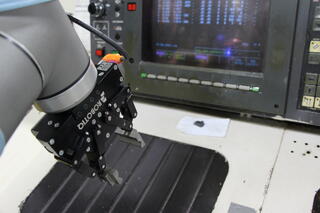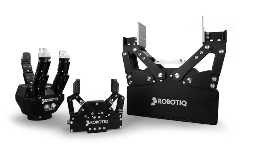Grippers for Collaborative Robots VS Grippers for Industrial Robots

Posted on Sep 08, 2014 in Robot Grippers
4 min read time
The force-limited collaborative robots are robots that can work side-by-side with human workers. The most prominent examples of such robots are Universal Robots, Rethink Robotics' Baxter and KUKA iiwa though there are many others starting to enter the market. Collaborative robots are beginning to gain serious momentum in the industry. What sets them apart from the industrial robots that we're used to seeing? What is the impact of these differences on the robot gripper?

The gripper, being one part of the complete solution, is highly dependent on the application and of the robot used. So let’s look at the differences between the two types of robots.
The main specifications of a gripper are payload, speed and repeatability. These specifications must match the robot they’re installed on. For collaborative robots, we are in the human scale, while for traditional robots, the spectrum is much broader.
Collaborative robots can usually be taught by demonstration, making it simpler to program than using the traditional approaches like teach pendant programming or offline programming. Ideally, we’d like the gripper to be seamlessly integrated into this workflow.

For some applications, it is safe enough to have operators share the same workspace with the collaborative robot. The traditional robot is almost always separated from the operator workspace. Again, we’d like a gripper that does not compromise the safety of the workers.
Collaborative robots are usually doing simple, stand alone applications. But these applications can change frequently so you want a flexible gripper. The traditional industrial robots are optimized for specific applications to squeeze the most productivity out of them. You have welding robots, painting robots, material handling robots. They are usually integrated into a large factory infrastructure, in many cases a PLC (programmable logic controller) will be scheduling the robot. Then, you want the gripper also to be optimized to get the most out of the repetitive robot action.
Gripper Specifications
For safety reasons, the payload of the force limited collaborative robots is also limited. So you need the best grip with the lightest weight, you need good grip-to-weight ratio. In a traditional application, weight is not that much of an issue. The strategy is often to use an oversized robot just to be sure it will be able to handle the application and the size of the robot doesn't have a significant impact on the price of the robot. (Blog Article on Payload)
Speed is about cycle time. In collaborative robots, speed is still important although the expectations are lower. Also, a super fast gripper has more potential to do harm if the robot and the human share the same workspace.
If repeatability is critical, most of the time you’ll get asked to have a gripper repeatability added to a robot repeatability that is below a certain limit. We should note however that there is no standard method to calculate gripper repeatability that all gripper manufacturers are presently using.
The durability in collaborative robots is not as stringent as on traditional robots. Gripper must be able to withstand the impact of a robot for a certain payload. On a 100 kg payload robot, you need a very bulky gripper and potentially a collision detector. On a collaborative robot, because of the low payload, speed and / force limitation, the risk of gripper impact or damage is not as high. Still, you need a reliable gripper, so that you don’t have to stop the robot when it is working because you need to do maintenance or repairs on the gripper.
The processes that collaborative robots perform most of the time are simple picking and placing. You need a gripper that can pick a wide range of parts in terms of stroke, grip force, form factor, etc. In many instances, the problem is not grasping the part as much as it is reaching the part. If you’re in a collaborative environment, chances are you are in a human scaled environment, including human scaled packaging. This challenge is in many cases underestimated when looking at an application.
Usually, as collaborative robots are used with humans around, the environment is much cleaner with limited dust, moisture, etc. Which again, can be tougher on your typical industrial robot job.
As you see, in many ways, collaborative robots are easy on grippers, but they offer a different set of challenges. As collaborative robots are repurposed regularly, grippers need to be flexible and easy to program. They should also be safe for the specific application.


.jpg)





Leave a comment